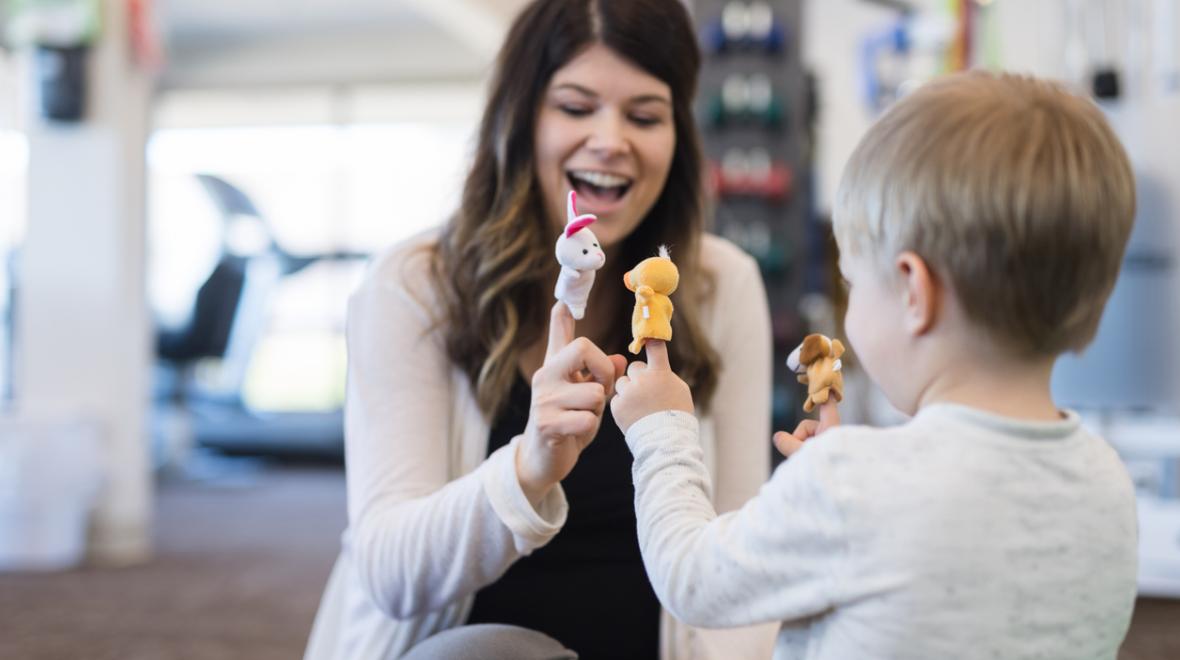
A certainty: If you walk into the Wallingford office of Michelle Warsing, you will want to plop down and play. Painted in shades of white and sky blue, the airy space is lined with orderly shelves and crates of toys, games and props. There’s a wooden castle and a dollhouse. There are squishy toys. There’s a sunny corner amply stocked with stuffed animals and cushions. There are Playmobil vehicles and figures, Legos, a toy cash register, cardboard blocks, wooden blocks and an art table with craft supplies. There are costumes and a box of puppets for dramatic play, a pop-up tent for hiding, and blankets and pillows for fort-building.
There are foam swords. There’s a blue cloth swing hanging from a rope. “A lot of 9- to 11-year-old boys will sit in here and wrap themselves fully in. This can be where we maybe get to the talking piece,” says Warsing.
You might especially be drawn to a wooden tray filled with fine, white glittery sand and — near the sand tray, behind a curtain — the shelves of figures and small props for placement in the sand tray.
“The idea is that almost everything in their real life is represented somewhere in this room,” says Warsing, who has a masters in marriage and family therapy with a certification in play therapy and who practiced at Seattle’s Hallowell Todaro ADHD Center before opening her private practice.
She sees kids ages 5–12 for a variety of issues, including anxiety, depression, sensory processing difficulties and childhood trauma. “Play therapy is the way to really communicate with kids and access their world,” she says.
How does play therapy work?
After meeting with parents to define the goals of therapy — improved social skills, for example, or reduced anxiety — the first few sessions focus on establishing a connection between the therapist and the child, with the child free to choose toys and play as she wishes. “The belief is that when given the appropriate and right environment and in the safety of a connected relationship, the child will work towards their own growth and healing,” says Warsing.
“Maybe they want to play themselves that day and play out what it feels like for them on the playground. They might choose another character and play out who that is, so it gives them the psychological distance from their real life,” she says. Older kids might gravitate to the sandplay table, she says, where they can “use any of the things on the wall to create their world in the sand.”
Play therapy is the way to really communicate with kids and access their world.
Once the connection is solid, Warsing might start including some “directive” time near the end of the session. “That’s where I'm working with them to develop skills to understand their emotional experience, and understand what’s going on in their body and in their brain.” (There is a range of how much directive time is included, with some therapists using an almost completely non-directive approach.)
Depending on the child and the issues, sessions might last around six months, with time built in during the final sessions towards phasing out and making sure parents and the child are equipped with new skills.
Play therapy has been an established form of therapy for children for more than 60 years, and a number of randomized controlled trials and observational studies indicate that it can be effective for a range of childhood difficulties.
Cary McAdams Hamilton, LMHC, who has a play therapy practice in Olympia and is director of the play therapy certification program at Seattle’s Antioch University, says that play therapy has been “proven to help children with anxiety, depression, ADHD, social peer conflict and trauma.” She recommends that parents make sure that a therapist is a registered play therapist; they can learn more and find providers in their area on the Association of Play Therapy website.
Barrett Greenwood, a marriage and family therapist and substance abuse counselor at Fort Lewis, turned to play therapy for his then-preschool-age son when the child was having a rough transition to preschool, “basically having meltdowns every day.”
“It was amazing to see the change in his emotional regulation and to hear the things he was processing through play,” says Greenwood. “I was blown away at the things he was doing through imaginative play.”
They returned to play therapy again when his son was in first grade and again showing signs of adjustment issues. This time, their play therapist also trained the parents in how extend the benefits of play therapy by doing child-directed play sessions with their son at home. They’ve noticed improvements in his capacity to understand boundaries and to identify and regulate his emotions.
“It’s helped him get in touch with what’s happening. It’s cut down on the meltdowns; he’s able to better regulate and he’s not being shamed for feeling that way,” says Greenwood.
Play therapy isn’t necessary — or right — for every kid, but every parent can draw inspiration from the idea that play connects and heals. Warsing encourages families she works with to look for everyday opportunities to get playful with each other and laugh, even on busy days.
“We adults know that there is a heaviness to life, right?” she says. “There are timelines, there are deadlines, there are routines. … When we play, when we’re playful, when we laugh, that’s how the endorphins are released and cortisol is lowered. So, it’s not just about ‘Let’s play,’ it’s about getting playful with life.”











